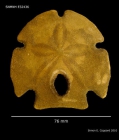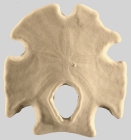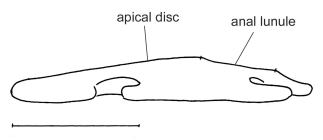Echinoidea taxon details
Encope grandis L. Agassiz, 1841
513256 (urn:lsid:marinespecies.org:taxname:513256)
accepted
Species
Echinoglycus grandis (L. Agassiz, 1841) · unaccepted (unaccepted combination)
Encope agassizi Michelin, 1851 · unaccepted (subjective junior synonym)
- Subspecies Encope grandis inezana Durham, 1950 †
marine, brackish, fresh, terrestrial
recent + fossil
Agassiz, L. 1841. Monographies d'Échinodermes vivans et fossiles. Échinites. Famille des Clypéasteroides. 2 (Seconde Monographie). Des Scutelles. Neuchâtel, Switzerland, i-iv, 1-151, pls 1-27., available online at https://www.biodiversitylibrary.org/page/1395637
page(s): 57-58; pl. 6: figs 1-9 [details]
page(s): 57-58; pl. 6: figs 1-9 [details]
Fossil range Durham (1940) described possible fossil representatives of E. grandis as ancestral species/subspecies, with E. shepherdi...
Fossil range Durham (1940) described possible fossil representatives of E. grandis as ancestral species/subspecies, with E. shepherdi restricted to the Late Pliocene and E. grandis inezana restricted to the Pleistocene. Morphological differentiation between E. grandis, and E. grandis inezana are very slight, and relates to small differences in the size of the marginal notches, the size of the interambulacral lunule, and the concavity of the abactinal system. Coppard & Lessios (2017) observed such characters to vary greatly in extant E. grandis and, thus, do not reliably differentiate these forms. They therefore used the Gelasian Stage of the Early Pleistocene for the minimum age of E. grandis. [details]
Kroh, A.; Mooi, R. (2021). World Echinoidea Database. Encope grandis L. Agassiz, 1841. Accessed at: http://www.marinespecies.org/echinoidea/aphia.php?p=taxdetails&id=513256 on 2025-04-08
original description
Agassiz, L. 1841. Monographies d'Échinodermes vivans et fossiles. Échinites. Famille des Clypéasteroides. 2 (Seconde Monographie). Des Scutelles. Neuchâtel, Switzerland, i-iv, 1-151, pls 1-27., available online at https://www.biodiversitylibrary.org/page/1395637
page(s): 57-58; pl. 6: figs 1-9 [details]
original description (of Encope agassizi Michelin, 1851) Michelin, H. 1851. Description de quelques nouvelles especes d'Échinides. Revue et Magazine de Zoologie, Série 2 3, 90-93., available online at https://www.biodiversitylibrary.org/page/2320997
page(s): 90-91; pl. 2: fig. 1a-b [details]
basis of record Mortensen, T. (1948). A Monograph of the Echinoidea. IV, 2. Clypeasteroida. Clypeasteridæ, Arachnoidæ, Fibulariidæ, Laganidæ and Scutellidæ. 471 pp., C. A. Reitzel, Copenhagen.
page(s): 437-438 [details]
status source Coppard, S.E. & Lessios, H.A. (2017). Phylogeography of the sand dollar genus Encope: implications regarding the Central American Isthmus and rates of molecular evolution. <em>Scientific Reports.</em> 7(1): 11520., available online at https://doi.org/10.1038/s41598-017-11875-w [details]
page(s): 57-58; pl. 6: figs 1-9 [details]
original description (of Encope agassizi Michelin, 1851) Michelin, H. 1851. Description de quelques nouvelles especes d'Échinides. Revue et Magazine de Zoologie, Série 2 3, 90-93., available online at https://www.biodiversitylibrary.org/page/2320997
page(s): 90-91; pl. 2: fig. 1a-b [details]
basis of record Mortensen, T. (1948). A Monograph of the Echinoidea. IV, 2. Clypeasteroida. Clypeasteridæ, Arachnoidæ, Fibulariidæ, Laganidæ and Scutellidæ. 471 pp., C. A. Reitzel, Copenhagen.
page(s): 437-438 [details]
status source Coppard, S.E. & Lessios, H.A. (2017). Phylogeography of the sand dollar genus Encope: implications regarding the Central American Isthmus and rates of molecular evolution. <em>Scientific Reports.</em> 7(1): 11520., available online at https://doi.org/10.1038/s41598-017-11875-w [details]
 Present
Present  Inaccurate
Inaccurate  Introduced: alien
Introduced: alien  Containing type locality
Containing type locality
From editor or global species database
Fossil range Durham (1940) described possible fossil representatives of E. grandis as ancestral species/subspecies, with E. shepherdi restricted to the Late Pliocene and E. grandis inezana restricted to the Pleistocene. Morphological differentiation between E. grandis, and E. grandis inezana are very slight, and relates to small differences in the size of the marginal notches, the size of the interambulacral lunule, and the concavity of the abactinal system. Coppard & Lessios (2017) observed such characters to vary greatly in extant E. grandis and, thus, do not reliably differentiate these forms. They therefore used the Gelasian Stage of the Early Pleistocene for the minimum age of E. grandis. [details]



